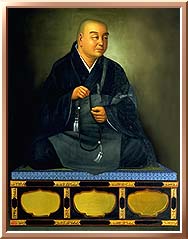 |
Honen
Shonin |
Honen Bo Genku (1133-1212 CE), more familiarly known as Honen, was part of the movement—along with Dogen, Nichiren and Shinran, his disciple—that resulted in the uniquely Japanese forms of Buddhism.
Buddhism first came to Japan in the sixth century CE from South Korea. By that time the religion had evolved in two directions, the more conservative Therevada Buddhism, which was prevalent in India and Southeast Asia, and Mahayana Buddhism, which had spread to North India, China and Tibet, and from there to Korea and Japan.
From the beginning, the most common form of Buddhism in Japan was the Mahayana school. Various sects developed, including Shingon, an esoteric form of Buddhism similar to the Tantric Buddhism of Tibet, and Tendai, a conservative monastic form.
When the shogunate took power in the 1100s, and the capital moved to Kamakura, new forms of Buddhism were introduced to Japan. The most popular was Zen, which further evolved into two different forms, Rinzai, and Soto. Another form of Buddhism which arrived in the Kamakura era was known as Jodo-kyo ‘pure land’. This type of Buddhism looked to Amida Buddha for salvation, and one of its primary rituals was repetition of the nembutsu—the phrase “Namu Amida Butsu”, which can be translated as “I take refuge in Amida Buddha”.
Born in 1133 CE, Honen Bo Genku entered monastic life at age 13, and for the next thirty years he underwent intensive training in Tendai Buddhism. At age 43, following exposure to the Pure Land teachings of the Chinese Master Shan-tao, Honen broke with the centres of Buddhism patronized by the royal court and military authorities to pursue his own spiritual vision.
In the spring of 1175, he founded Jodo Shu in Japan, the way of salvation by a power beyond the individual. The nembutsu had been practiced in Japan before Honen, but it had only secondary meaning as a religious discipline. Honen, however, taught that rebirth in the Pure Land was certain for anyone who recited the name with complete trust and sincerity.
Honen believed that most people, himself included, could not achieve liberation on their own. He eliminated the intellectual difficulties and complex meditation practices used by other schools of Buddhism, teaching that the only way to achieve buddhahood was with the help of Amida.
The result was a form of Buddhism accessible to anyone. The centre of his teaching was at Yoshimizu, where Chion-in, the head temple of Jodo Shu, remains. Honen’s teachings attracted many, including not only priests and nobles, but also warriors, fishermen, prostitutes and other social outcasts. Those who followed Jodo-Shu believed that constant repetition of the nembutsu would lead to their salvation. Honen’s disciple, Shinran, came to believe that saying the nembutsu once would also be effective—as long as it was done with a pure heart.